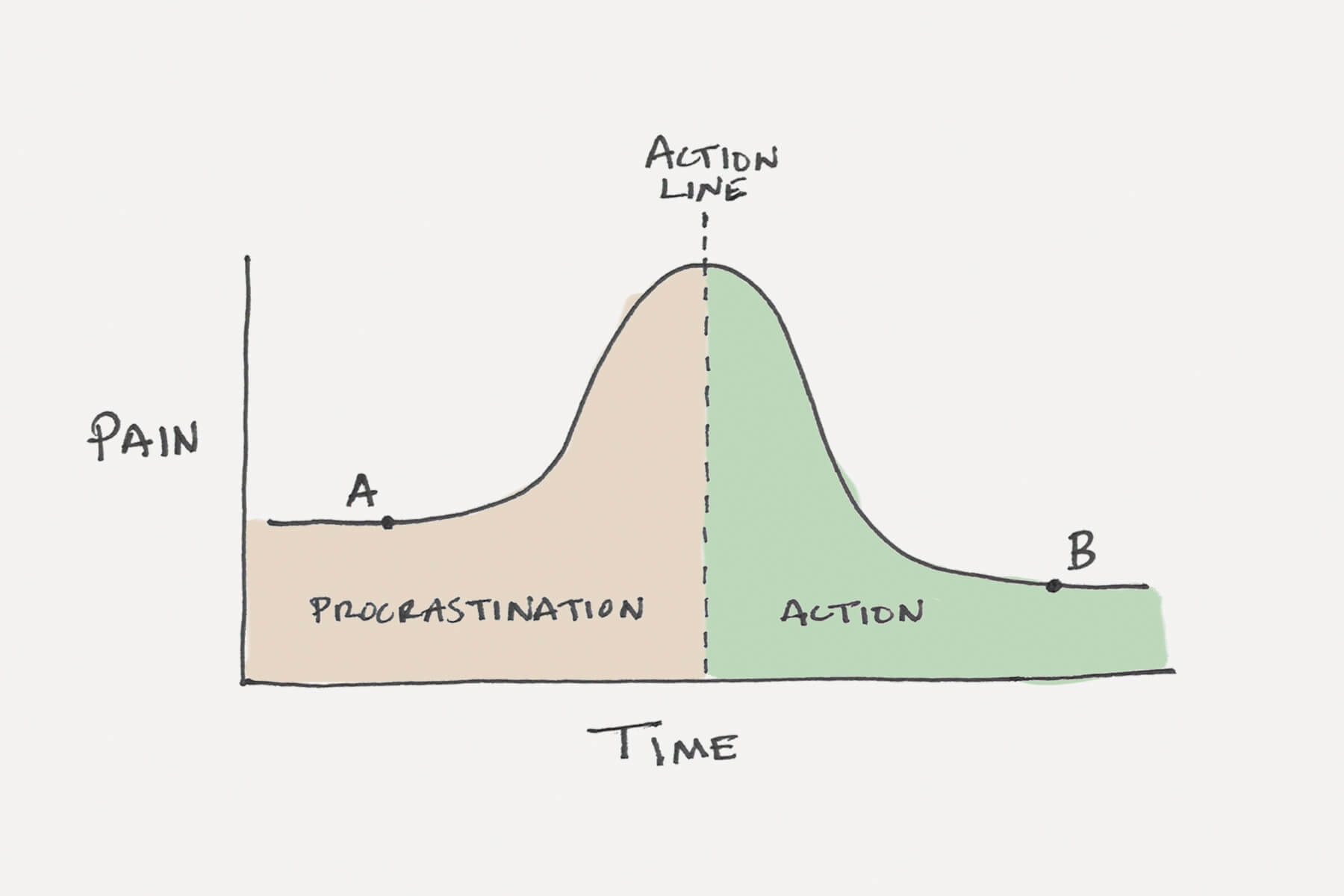How to Stop Procrastinating

I experienced a paradigm shift with regard to procrastination after reading Charlotte Lieberman's article for the New York Times on the subject. I used to think I had a strong handle on procrastination, as I rarely caught myself putting off work for leisure. I did however sometimes find myself putting off important tasks (such as writing a cover letter for a job application) by doing other productive although less urgent tasks (such as alphabetizing my book shelf). After all, alphabetizing requires focus and effort, so I knew it wouldn't be fair to characterize myself as lazy. It's not like I was hanging out with friends or watching Netflix instead of writing my cover letter.
Lieberman helped me understand that what I was doing was just a form of procrastination hiding under the illusion of productivity. I have since done a lot of reading and research about procrastination in order to better understand it. Here is a collection of insights as well as some tools I've found useful in taming my urge to procrastinate. I've included a list of references at the end in case you'd like to dive deeper into the subject.
Key Insights
- Procrastination is an emotional regulation problem, not a time management problem
- The hardest part is getting started (action-line)
- Motivation follows action
What is procrastination?
- Procrastination is the act of delaying or postponing a task or set of tasks, even if you are putting off one task to do another
- Procrastination is not new, Ancient Greek philosophers developed a word for it – Akrasia – meaning to act against our better judgement by doing one thing even though we know we should be doing something else
Why do we procrastinate?
Emotional Regulation
- Procrastination is an emotion regulation problem, not a time management problem
- We procrastinate to avoid challenging emotions and negative moods induced by certain tasks
- The nature of our aversion to a task stems from one of two things: (1) something inherently unpleasant about the task and (2) deeper feelings related to tasks such as self-doubt, low self-esteem, anxiety, or insecurity
- Aversions lead to us putting off tasks providing momentary relief, which in turn creates more aversion, resulting in a vicious cycle of procrastination
- To overcome procrastination, it's important to realize that at its core, procrastination is about emotions, not productivity
Present Bias
- Procrastination is a perfect example of present bias, our hard-wired tendency to prioritize short-term needs ahead of long-term ones
- The best way to understand this is by imagining that you have two selves: your present self and your future self
- You can set whatever goal you want for your future self, but its your present self that has to actually do the action to get there
- Although the future self values long-term rewards, the present self values instant gratification
- This disconnect is what psychologists refer to as time inconsistency, and is one of the reasons why we procrastinate
Momentum
- Most of the resistance we feel in doing a task is in the act of starting
- The pain of starting a task is large, but quickly subsides after starting
- The "action line" occurs at the point where the pain of procrastinating exceeds the pain of beginning a task, leading us to stop procrastinating
- As soon as we cross the action line, the pain of procrastination begins to subside
- This means that the problem is not doing the work, it's getting started
- This is analogous to a ball rolling down a hill — its hard to initially push the ball to get it rolling, but once its rolling down the hill, it doesn't take much force to keep it going

Motivation
- A paradigm shift concerning motivation is necessary to overcome procrastination
- Motivation comes after starting, not before, therefore motivation is not the cause of action, its a result of action
- Instead of thinking about motivation, you should think about discipline and habits
- Discipline is energy that we've put into the system using our willpower
- Once we do something enough, it becomes a habit, and no longer takes willpower
Tools to help you stop procrastinating
2 Minute Rule
If you have a pending task that can be done in less than two minutes, then do it right away
5 Minute Rule
If you are finding yourself procrastinating from something you have to do, tell yourself that you will only do it for 5 minutes
Mind Activation Rule
If you feel that you are in a slump – when your mind is in a hazy state and you don't feel like doing anything – which often occurs after lunch of when you get home from work, do something to stimulate your mind. You can use both pharmacological methods (such as caffeine) or non-pharmacological methods (such as exercise).
Bigger Better Offer
To overcome procrastination, we need to find a better reward than avoidance (one that can relieve our challenging feelings in the present moment without causing harm to our future selves). Some ways you can do this include:
- Forgive yourself in the moments you procrastinate
- Practice self-compassion (treat yourself with kindness and understanding in the face of your mistakes and failures)
- Reframe the task and instead consider the positive aspect of it (such as reminding yourself of a time when you did something similar and it turned out alright, or thinking about the beneficial outcome of completing a task)
Managing Feelings That Trigger Procrastination
Bring attention to sensations arising in your mind and body when you are tempted to procrastinate, consider only the next action rather than breaking up the task into chunks, and make temptations inconvenient and tasks as easy as possible.
Making It Easier To Get Started
To overcome procrastination, we need to make it as easy as possible for the present self to get started and trust that motivation and momentum will come after we begin:
- Make the rewards of taking action more immediate (ex: temptation bundling — only do [thing you love] while doing [thing you procrastinate on])
- Make the consequences of procrastination more immediate (ex: finding a workout partner or placing bets against yourself)
- Design your future actions (make procrastinating more difficult by using commitment devices to increase the friction of procrastination temptations, such as deleting your social media apps)
- Make the task more achievable (make tasks easier to start by using strategies such as the 2-minute rule or by breaking down tasks)
The Ivy Lee Method
Comprised of the following five steps:
- At the end of each work day, write down the six most important things you need to accomplish tomorrow. Do not write more than six tasks.
- Prioritize those six items in order of their true importance.
- When you arrive tomorrow, concentrate only on the first task. Work until the first task is finished before moving on to the second task.
- Approach the rest of your list in the same fashion. At the end of the day, move any unfinished items to a new list of six tasks for the following day.
- Repeat this process every working day.
Why the Ivy Lee Method is so effective:
- It's simple
- It forces you to make tough decisions
- It removes the friction of starting
- It requires you to single-task (rather than multi-task)
Regardless of what method you choose, the bottom line is: Do the most important thing first each day and let the momentum of the first task carry you into the next one.
Visual Cues
You can use visual cues to trigger your habits and measure your progress. A visual cue is something that you can see that prompts you to take action (i.e., an action reminder). Visual cues are important for three reasons: they remind you to start a behavior, they display your progress on a behavior, and they have an additive effect on motivation. Two examples of strategies which employ visual cues are the paper clip strategy and the Seinfeld strategy.
Paper Clip Strategy: Two jars, one with 120 paperclips, the other one empty. Every time you do the required action (ex: make a sales call), move one paperclip to the other jar.
The Seinfeld Strategy: Get a big wall calendar and a big red magic marker. Every day that you do the required task, put a big red X over that day. After a few days, you'll have a chain. Just keep at it and chain will grow longer every day. Your only job is to not break the chain (mastery follows consistency).
References
Books
- A Mind For Numbers: How to Excel at Math and Science - Barbara Oakley
- Atomic Habits - James Clear
- Getting Things Done - David Allen
Articles






Member discussion